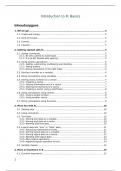Samenvatting
Samenvatting statistiek, deel 3: software - Introduction to R
- Instelling
- Katholieke Universiteit Leuven (KU Leuven)
Hele samenvatting van Introduction to R van het vak statistiek voor psychologen, deel 3: software Geslaagd van de eerste keer met 17/20
[Meer zien]



